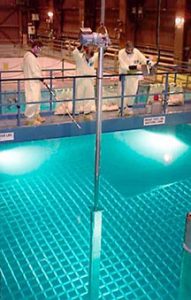Currently, spent fuel is being stored in at-reactor (AR) or away-from-reactor (APR) storage facilities, and we can identify two basic solutions of interim storage:
- Dry Storage, where natural air circulation dissipates heat.
- Wet Storage, where water is used as the heat conductor.
Wet Storage of Spent Fuel

Wet storage of spent nuclear fuel in wet storage pools is a common practice worldwide. It is very similar to at-reactor spent fuel storage, but in this case, storage facilities are usually for many power plants. Irradiated fuel is due to the presence of a high amount of radioactive fission fragments and transuranic elements that are very hot and very radioactive. Reactor operators must manage the heat and radioactivity that remains in the “spent fuel” after it’s taken out of the reactor. In nuclear power plants, spent nuclear fuel is stored underwater in the spent fuel pool on the plant. Plant personnel moves the spent fuel underwater from the reactor to the pool. Over time, as the spent fuel is stored in the pool, it becomes cooler as the radioactivity decays away. After several years (> 5 years), decay heat decreases under specified limits so that spent fuel may be reprocessed or interim storage. Many regulators have determined that dry storage of spent fuel at reactor sites is safer than wet storage. True AFR storage pools are independent of the reactor and all its services and can continue to operate after the reactor has been finally shut down and decommissioned. Centralized interim storage does not eliminate the need for developing a long-term disposal option, but it might provide other benefits.
A typical wet storage facility may have the following features:
- Cask reception, decontamination, unloading, maintenance, and dispatch
- Underwater spent fuel storage (pool);
- Auxiliary services (radiation monitoring, water cooling and purification, solid radioactive waste handling, ventilation, power supply, etc.).
Spent fuel pools are fitted with stainless steel and aluminum racks that hold the fuel assemblies and are lined with stainless steel to prevent leaking. No drains would allow the water level to drop or the pool to become empty. The plants have a variety of extra water sources and equipment to replenish the water that evaporates over time or in case of a leak. Plant personnel is also trained and prepared to respond to a problem quickly. The water serves two purposes: it cools the fuel and shields workers at the plant from radioactivity. Although water is neither high density nor high Z material, it is commonly used as a gamma shield. Water provides a radiation shielding of fuel assemblies in a spent fuel pool during storage or transport from and into the reactor core. Although water is a low-density and low Z material, it is commonly used in nuclear power plants because these disadvantages can be compensated with increased thickness.
To conserve space, in all plants, open storage racks were replaced with so-called high-density racks that incorporate (boron-10) or other neutron-absorbing material to ensure subcriticality. Fuel assemblies can be stored in about one-half the volume required for storage in standard racks using such racks.
Safety of Spent Fuel Pool
The safety of AFR spent fuel pools stands on various criteria. These criteria are usually very similar to the criteria for AR pools and may be grouped according to the following aspects:
- Subcriticality. Fulfillment of this criterion is based on:
- the design of the spent fuel pool,
- requirements on boric acid diluted in water,
- limiting of stored fuel (e.g., fuel enrichment, assembly burnup)
- Cooling. Fulfillment of this criterion is based on:
- the design of the spent fuel pool (e.g., no drains below the top of the stored fuel elements),
- requirements on the water level in the pool,
- requirements on active cooling elements (heat exchangers and heat sink).
- Radiation Shielding. Fulfillment of this criterion is based on:
- the design of the spent fuel pool (water and concrete shielding),
- the design of the surrounding working area
- requirements on the water level in the pool,
- Integrity. Fulfillment of this criterion is based on:
- the design of the spent fuel pool,
- the design of the surrounding working area,
- ensuring periodic inspections